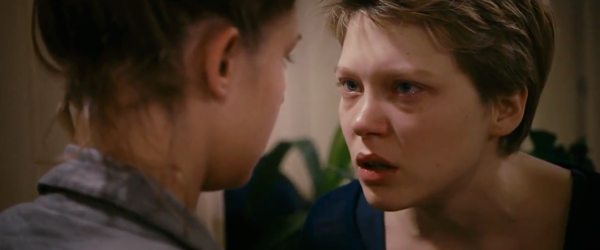Celebrated at Cannes, banned in Boise and breathlessly hyped in the rest of civilization,
Blue is the Warmest Color is ultimately a big - at three hours running time very big - bag of only OK. This Millennial coming-of-age story has delighted critics and film festival judges for the last six months for reasons that totally evade this reviewer. Its lengthy and stark depictions of lesbian lovemaking have justifiably been the talk of film snobs the world over, but remove those titillations and what’s left is a fairly conventional romantic drama, distinguished only by clumsy and trite sexual metaphors.

It’s easy to see why the Cannes jury took the unusual step of awarding the Palme d’Or not only to director Abdellatif Kechiche but to leading ladies Léa Seydoux and Adèle Exarchopoulos as well. One could argue that their performances are the film’s only saving grace and Kechiche’s contributions are more impediment than enhancement. For some reason, he insists on shooting 95% of the film in close-up which establishes claustrophobia along with intimacy. Only in the sex scenes and during a sequence filmed near a big tree in a city park does Kechiche allow his camera to widen and his audience to breathe. His insistence on the micro extends to a dinner party scene where sophisticated folks are shown slurping spaghetti in a film school cunnilingus analogy. Yes, eating and sex have certain similarities. We get it.
Blue is the Warmest Color is based on a graphic novel, which likely accounts for the story’s lack of depth. Here we meet Adèle (Adèle Exarchopoulos), a pretty high school student with her head in the clouds and her hormones ripe for the picking. One day while going to meet a boy (Salim Kechiouche) for a lunch date, she passes an avant-garde art student named Emma (Lea Seydoux); her hair dyed an arresting shade of bohemian blue. Over the ensuing weeks, Adèle will find traditional notions of romance unsatisfying, and has recurring intimate visions of the mysterious woman with the azure tresses. Then one night, she has a chance meeting with Emma at a bar, altering the path of her life as the fantasies becomes real.

What follows is typical of the romantic drama arc, especially romances between older, more experienced lovers and giddy neophytes. In the fullness of time, the devoted Adèle becomes little more than a hausfrau, preparing the meals and washing the dishes after festive soirees designed to advance Emma’s artistic career. As her professional stature grows, Emma repays the naive Adèle with a wandering eye and a hyper-critical mouth.
Adèle eventually finds a career as a first grade teacher and, thanks to Exarchopoulos, these largely improvised classroom scenes are some of the film’s most genuine and organic. Kechiche is keenly aware that he’s struck gold here, and wisely allows these sequences to dominate
Blue is the Warmest Color’s third hour. When all this exposure to kids causes Adèle to consider a brood of her own, Emma rejects the idea out of hand, setting up the conflict that will finally sever them. All this Lifetime TV stuff is separated by sex scenes that are as graphic and detailed as advertised. By the end of the film viewers will find both Léa Seydoux and Adèle Exarchopoulos devoid of any anatomical mystery.

In her short career, Seydoux has become one of the great criers in cinema, able to summon convincing abject weeping at a moment’s notice, but here Exarchopoulos proves to be formidable competition. As things get ever more rocky, the pair sob their way to breakup with Kechiche’s 80mm lenses capturing every glistening drop of bodily fluid. A bittersweet flash forward gives both ladies a chance to tear up one last time, as Adèle forlornly hopes for an impossible reconciliation. It’s a scene complete with loud gurgles and aggressive gropes, affecting in its own way but stolen - intentionally or not - from
Last Tango in Paris, a far superior film from 40 years ago that makes
Blue is the Warmest Color look even more pathetic in comparison.
In recent weeks, a pissing contest has broken out in the press between Kechiche and Seydoux, with each taking turns trashing the other. At first it was just kind of amusing, but after seeing the film, one gets a better understanding of the feud’s genesis. Despite all the accolades, despite the stunningly courageous performances of Exarchopoulos and Seydoux,
Blue is the Warmest Color just kind of lays there like a lox. Narrative cliches can be dressed up in hot sex and alternative lifestyles - or undressed in this case - but they remain narrative cliches. Unfortunately, films like this may become epidemic. Lars van Trier is scheduled to unveil
Nymphomaniac this Christmas; a film that boasts a number of A list stars - Charlotte Gainsbourg among them - in various state of buck-nekid writhing. Funny how things change. Porn used to be something serious directors only did in-between jobs.












7 comments:
boring ass "review" by a stupid snarky arrogant dismissive "reviewer". Don't remember criticism of such for Brokeback Mountain but it's French and 2 women
I still want to see it.
Yes I hate lesbians and Lea Seydoux. You don't know a thing about my work asshole so shut the fuck up.
Marceline: Please do and let me know what you think.
I don't want to see it, but I enjoyed your review immensely.
Thanks!!!!
Post a Comment